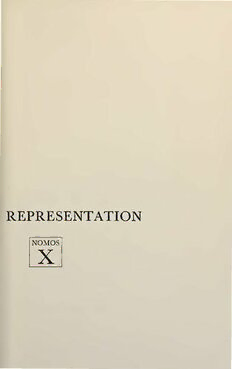Table Of ContentREPRESENTATION
INXS
NO MOS
I Authority 1958 ( out of print)
II Community 1959 (out of print)
III Responsibility 1960 ( out of print)
IV Liberty 1962
V The Public Interest 1962
VI Justice 1963
VII Rational Decision 1964
VIII Revolution 1966
IX Equality 1967
X Representation 1968
R E P R E
S E N T A T I O N
Yearbook of the American Society for Political and Legal Philosophy
(;.~
Edited by ] ~ROLAND ,:f ENNOCK
Swarthmore College
and JOHN W. CHAPMAN
University of Pittsburgh
A T H E R T O N P R E S S • New York • 1968
U 110.s-1
c:,
)
.::,
(
r, .. .
.
., ;-:-.
'j
REPRESENTATION: Nomos X
J. Roland Pennock and John W. Chapman, editors
Copyright © 1968 by Atherton Press, Inc.
All rights reserved. This book may not be
reproduced in whole or in part by mimeography,
photoduplication, or any other means without
the prior written consent of the publisher.
Address all inquiries to:
Atherton Press, Inc.
70 Fifth Avenue, New York 10011
Library of Congress Catalog Card Number 68-16404
FIRST EDITION
Manufactured in the United States of America
75497
PREFACE
vVhether the concept of representation may be usefully em-
ployed in political theory and analysis has been questioned, for, as
in the case of many terms in our vocabulary, scrutiny quickly reveals
its meaning to be vague and ambiguous. Such a concept is bound to
arouse the suspicion of those bent upon the achievement of scientific
precision. Would we not be better off without it? Could we not rely
upon some more operational equivalent? Or does the way to greater
clarity run through linguistic and theoretical refinement? The latter
course is pursued in this volume; and at least two considerations,
one practical and the other philosophical, suggest that our appre-
ciation of the nature of political activity will thereby deepen.
In the first place, whether we like it or no, the concept of repre-
\, sentation will probably remain in use for some time to come. The
United States Supreme Court's decision in Baker v. Carr and in
Preface
Vlll
others that have followed-especially Gray v. Sanders1 in its enun-
ciation of the "one-man, one-vote" standard for the determination
of what is fair and constitutional representation-have assured the
concept a continuingly prominent place in the literature of political
and legal theory. An important, though incidental and unintended,
consequence of that line of judicial decision has been a revival, in
the United States and elsewhere, of thought and discussion about
representation. This volume, and the 1965 meetings of the American
Society for Political and Legal Philosophy that gave rise to it, at
least point in this direction. It is also worth noting that new concepts,
such as "contestation," invented for the purpose of analyzing political
relations in more imperfectly representative systems, take on their
meaning by way of reflection from the concept of representation:
we would seem to have in it one of those peculiarly practical forms
of abstraction that A. D. Lindsay called "operative ideals."
In the second place, one is inclined to look beneath mundane
usage and usefulness for roots in philosophic vitality. Here the
notion of "plastic control," introduced by Karl Popper to describe
the relation between two interacting and indeterministic systems,
offers an analogy that helps to account both for the difficulties en-
countered in rendering the concept of representation more precise
and for its operational capacities.2 A society does not determine the
actions of its representatives; a representative system does not de-
termine the shape and growth of its society. But between the two a
relation of mutual or "plastic" control does exist. It is this relation,
into which enter elements of both freedom and rationality, that this
volume, in part, seeks to elucidate.
Like its predecessors in this series, this collection of essays does
not pretend to completeness of coverage nor to sustained argument
throughout. Rather, we have aspired, in soliciting essays in addition
to those that were prepared for the meetings, to secure some analysis
of aspects of the subject that could not be dealt with on that occasion
and, at the same time, to maintain as much unity as practicable.
We note, with appreciation and thanks to Joel Feinberg, Profes-
sor of Philosophy at the University of California at Los Angeles,
1 372 U.S. 368 (1963).
2 S,ee Karl Popper, Of Clouds and Clocks: an Approach to the Problem
of Rationality and the Freedom of Man (St. Louis: Washington University
1966). - '
Preface IX
who served as Chairman of the Program Committee, that the con-
tributions by Professors Black, Brown, Cohen, Diggs, Dixon, Novak,
Pitkin, Riker and Shapley, and Stokes are lineal descendants, if not
replicas, of papers presented by these authors at the annual meetings
of the Society.
J. ROLAND PENNOCK
JOHN W. CHAPMAN
182683
CONTENTS
Preface Vll
THE CONCEPT OF REPRESENTATION
1 Political Representation: An Overview
J. ROLAND PENNOCK 3
Practical Representation
B. J. DIGGS 28
Commentary: The Paradox of Representation
HANNA PITKIN 38
4 Commentary: Representation and the Problem of Identity
JULIUS COHEN 43

